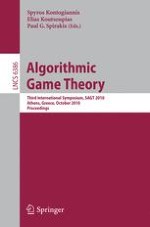2010 | Book
Algorithmic Game Theory
Third International Symposium, SAGT 2010, Athens, Greece, October 18-20, 2010. Proceedings
Editors: Spyros Kontogiannis, Elias Koutsoupias, Paul G. Spirakis
Publisher: Springer Berlin Heidelberg
Book Series : Lecture Notes in Computer Science
